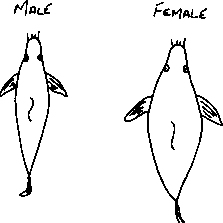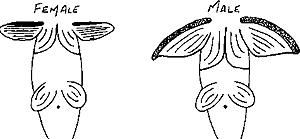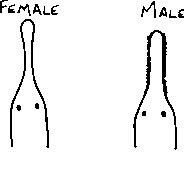The phone call came late one night.
"Pssst. Riverfront has some Aspidoras."
"Really? How do they look? Are there lots? How much are they?" But the click of the caller hanging up was my only answer.
Hot on the trail of my only lead, I went down to Riverfront the next day. The staff seemed to know why I was there and lead me to the tank of Aspidoras maculosus. (Am I that transparent?) All my questions of the night before were answered. They looked good, there were lots, and the price was reasonable.
I observed them for quite some time to determine which were male and which were female, but apart from a slight size difference they were all identical. I had 10 bagged up with a request for some large ones and some smaller ones. So much for all my observations on fin shapes and sizes and spots or absence of spots to determine sexual differences! My wish, of course, was to be able to spawn these new fish.
A visit to any fish store will provide many different varieties of catfish but one genus not often encountered is Aspidoras. The genus Aspidoras is comprised of approximately fourteen species and is generally distributed in the Amazon region, specifically in Brazil. They very closely resemble catfish of the genus Corydoras and at first glance are often mistaken for them. The characteristic that distinguishes Aspidoras from Corydoras and Brochis is the number and shape of the cranial fontanels of which Aspidoras have two while Corydoras and Brochis have only one. This is, unfortunately, not a very convenient method of identification in that it requires dissection of the fish. However, there are two external differences that are generally reliable and easy to spot. The most apparent feature is the size of the eyes. With the exception of Aspidoras pauciradiatus, the eyes of Aspidoras are very small for the size of the fish, much smaller than those of Corydoras or Brochis. The other difference is more subtle and deals with the general body shape. Aspidoras have a rounded head shape and a longer, slimmer body than Corydoras in general, but the tiny eyes is by far the most distinguishing feature of the genus.
The fish were given a 20 liter tank with Java fern, Java moss, a floating Anubias nana, and a sponge filter. Regular tap water was used: pH 7.8, hardness approx. 250 PPM. The water was warmed somewhat from the ballast of the light fixture on the lower level and the water temperature ranged from 27C to 28C. The fish were not fussy eaters. Flake food, white worms, live tubifex worms, and shrimp pellets were all eaten with relish and over a few months the larger females became much fuller in girth than the smaller males. But the fish did not spawn.
I knew of two aquarists who had also purchased some of these fish and were having spawning success so with some further sleuthing I learned that in one case, the eggs were laid on the uplift tube of the AquaClear filter and in the other case, the female actually jumped into the chamber of the AquaClear filter to deposit her eggs. Of course, Watson! I needed more current! To this end I added an AquaClear mini to one end of the tank. No filter medium was used in the chamber as the purpose was to increase the water current and the sponge filter was also still running to take care of biological filtration.
As I was feeding the fish late one night in February, three or four weeks after adding more current, I saw a female swimming with eggs in her pelvic fins. After three or four jubilant dances around the room I watched a bit longer but couldn’t see where the eggs were being placed. I wanted to wait until morning before moving the eggs to give them a chance to harden and minimize the chance of damaging them.
First thing in the morning, I looked for the eggs in the Java moss and on the back of the Java fern but there were none there, nor were there any on the glass. I eventually found the eggs on the underside of an Anubias leaf all clustered together in one clump. There were about 35 eggs and they all appeared to be fertile. I moved the cluster of eggs into a margarine container of tank water that had been lightly tinged with methylene blue. In my hunt for the eggs, I also found two fry living under the sponge filter. Hmm Watson, what could this mean? Obviously, there had been a previous spawn(s) that I had not detected.
The eggs developed very quickly and hatched in only three days. As soon as the fry hatched, they were moved to a small show tank with about two inches of fresh water. The fry absorbed their yolk sacs for another three to four days and then took brine shrimp nauplii as a first food. Unlike Corydoras fry, the Aspidoras fry undulate their tails constantly. Each day the bottom of the tank was siphoned with air line tubing to remove any uneaten food and detritus. Keeping the bottom of the tank clean is of paramount importance in preventing the growth of fungus. Fungus will attack the fry, usually starting at the end of the tail and traveling up the body, eventually killing the fish. The first signs are a clamped caudal fin and translucence of the tail. AquariSol administered in the regular dosage will help prevent fungus but scrupulous cleanliness is the best defense.
The fry grew very quickly, much faster than any cory fry I’ve raised, and it was necessary to move them into a 20 liter tank with a sponge filter and some rocks to hide under after about two weeks. The fry ate to the point where their bellies were very distended and looked so uncomfortable balanced on their swollen tummies, leaning on one pectoral fin that I often thought that throwing in a couple of Tums would do them a world of good. But they ate like that meal after meal without any ill effects and grew like weeds in the process.
Once I had discovered where the Aspidoras laid their eggs, I began to search regularly, and also began to find regularly, clusters of eggs almost always on the undersides of the Anubias leaves. I was never able to observe the T-formation of the spawning act and, in fact, the only spawning activity I ever witnessed was when I first saw the female swimming with eggs in her fins. I was able to determine that spawning always takes place late at night and eggs are always grouped in large clusters, usually one but sometimes two or three. I found this very interesting as it suggests a greater effort to hide the eggs from predators rather than scattering them all over the glass as with Corydoras aeneus. The parents never ate the eggs and there were many times that I found clusters of eggs on the verge of hatching. The fry, however, must be much tastier for they disappear if not removed from the tank although a few do find refuge under the filter.
I only experienced one problem with this fish and for a while it was quite a mystery to me. On occasion, I found a dead adult fish without a mark on it to indicate the cause of death. As the fish were eating and spawning and regular water maintenance was being done, I was at a loss to explain the deaths. The fish were full-sized when purchased so it was impossible to determine their age and I wondered if they were dying of old age (always a convenient excuse) but others also keeping this species were not having similar problems. Not very much literature is available on this genus of fish but I poured over what little there is. In two separate sources I found mention that Aspidoras like oxygen-rich water. I’m reasonably certain that the temperature of their tank water is too high to permit oxygen solubility at the necessary level to sustain as many fish as I was trying to maintain in one tank. In short, I think I suffocated some of them.
Many books recommend Corydoras paleatus or Corydoras aeneus for their relative ease of spawning as two species to try when first attempting to spawn a catfish but I have found this Aspidoras easier in both inducing spawning and raising of fry. In fact, I was so caught up in the joy of finding egg clusters, hatching and raising the fry that it took me some time to realize that I was overrun with kittens. At present, ten tanks in my fishroom have Aspidoras in residence and I’ve willed myself to stop looking for eggs. But like the Sorcerer’s Apprentice, I seem to have started something I can’t stop. The last time I did a water change and siphoned the detritus off the bottom of the tank, I found a newly hatched group of 40 fry in my water change bucket. These are currently living with a group of C. paleatus fry the same age. There are also eight fry about a half inch long growing up in the tank with the parents. The first fry, only 8 months old, have begun laying eggs, too. So, be careful what you wish for…
REFERENCES
Colored Atlas of Miniature Catfish, Warren E. Burgess, T.F.H. Publications Inc., 1992.
Aquarium Atlas, Volume 2, Hans A. Baensch and Dr. Rudiger Riehl, Hans A. Baensch GmbH, Melle, Germany, 1993.
Aquarium Atlas, Volume 3, Hans




